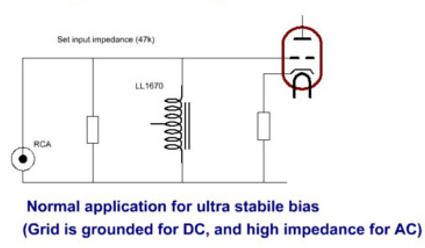Filter Chokes
A smoothing choke is an inductor which is used - primarily - for filtering in power supplies. Typically, they contain gapped iron cores with two leads, coming out of their housings. The current flowing through an inductor cannot change instantaneously, i.e. it resists change in current flow, making it a perfect candidate for power supply filtering. After rectification (conversion from AC to DC), chokes "smooth out" the ripple voltage.

Here is the full-size view of the image.
Directly above is a schematic for the power supply of an old Acrosound 100 Watt 6146 amp. In the 1950s, a supply with paralled tube rectifiers, a swinging choke (one whose inductance varies indirectly with current draw), a smoothing choke, etc. was the state of the art. Today, there's some dispute regarding the number and size of smoothing chokes that should be installed. Two or three smoothing chokes (of 2-3H each) in series with filter capacitors appear to provide less ripple voltage than a single choke of high (10H) inductance. Further, a voltage doubler of 275V could provide the necessary high voltage with less mass and lower cost - than the 825-0-825 transformer pictured.
Below, more exotic varieties of chokes (plate and grid) are designed to deliver DC current to the tubes in various stages of an amplifier.
Plate Chokes
Plate chokes provide inductance, showing a high impedance to AC signals yet a low DC resistance. In dropping voltages with plate resistors, they can generate massive heat and supply less driving power to the output tube - relative to plate chokes. Plate chokes are attached to a tube, instead of a plate resistor - at 3 to 7 times the value of the plate resistor. Below is an example of a plate choke in combination with a compactron, devised to drive a notoriously hard-to-drive transmitting triode - the 845. (Notice the 6HV5A? It appears a pentode, but it's really triode with "beam plates". The schematic is incorrect. The beam plates should be strapped to the cathode - not the plate. On an historical note, the 6HV5A was designed for use as a high-voltage regulator in the power supplies of color TVs. Many years later, it was co-opted for audio by dare-devil, tube amp designers - who run it at voltages exceeding 900V.)

Grid chokes
Grid chokes are high inductance coils - which like plate chokes - supply high impedance to AC signals but low DC resistance. They are substituted for grid leak resistors, putting a lower DC resistance on the grid of the driven tube than a resistor. Grid chokes are connected from grid pin to ground. Their low DC resistance stabilizes the bias current and lessens the load for the driving tube. From the Lundahl specs, a typical application of a grid choke:



